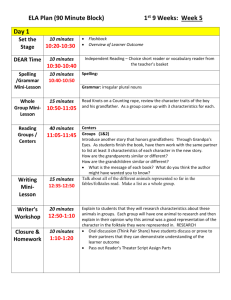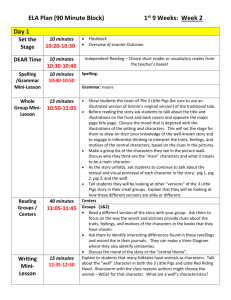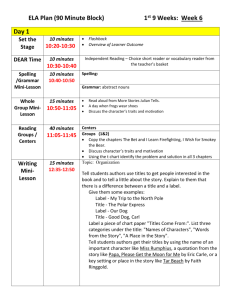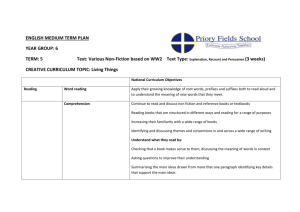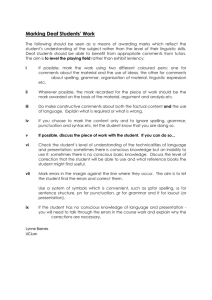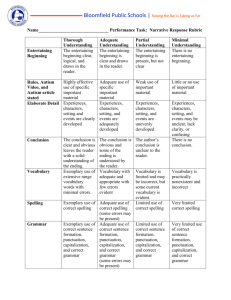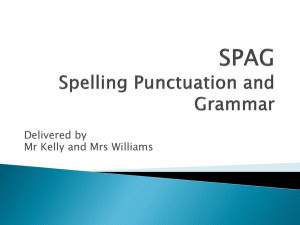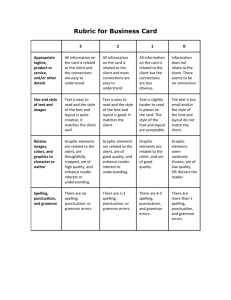ELA Week 1 Plan
advertisement
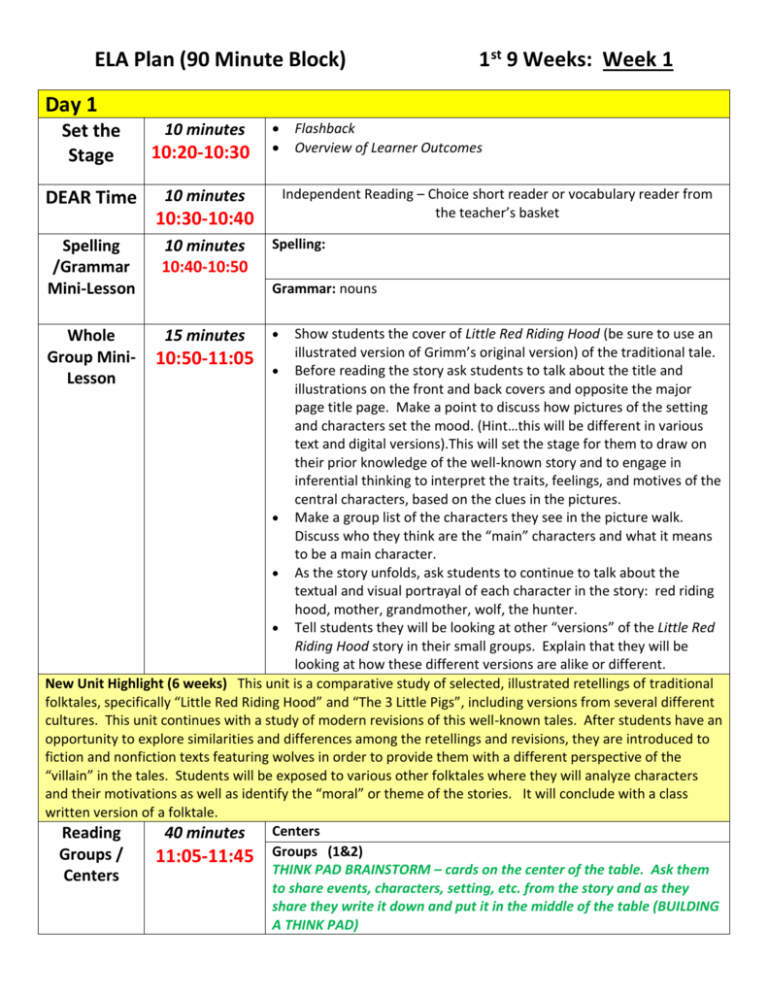
ELA Plan (90 Minute Block) 1st 9 Weeks: Week 1 Day 1 10 minutes Set the Stage 10:20-10:30 DEAR Time 10 minutes Independent Reading – Choice short reader or vocabulary reader from the teacher’s basket 10:30-10:40 Spelling /Grammar Mini-Lesson 10 minutes 10:40-10:50 Flashback Overview of Learner Outcomes Spelling: Grammar: nouns Show students the cover of Little Red Riding Hood (be sure to use an illustrated version of Grimm’s original version) of the traditional tale. 10:50-11:05 Before reading the story ask students to talk about the title and illustrations on the front and back covers and opposite the major page title page. Make a point to discuss how pictures of the setting and characters set the mood. (Hint…this will be different in various text and digital versions).This will set the stage for them to draw on their prior knowledge of the well-known story and to engage in inferential thinking to interpret the traits, feelings, and motives of the central characters, based on the clues in the pictures. Make a group list of the characters they see in the picture walk. Discuss who they think are the “main” characters and what it means to be a main character. As the story unfolds, ask students to continue to talk about the textual and visual portrayal of each character in the story: red riding hood, mother, grandmother, wolf, the hunter. Tell students they will be looking at other “versions” of the Little Red Riding Hood story in their small groups. Explain that they will be looking at how these different versions are alike or different. New Unit Highlight (6 weeks) This unit is a comparative study of selected, illustrated retellings of traditional folktales, specifically “Little Red Riding Hood” and “The 3 Little Pigs”, including versions from several different cultures. This unit continues with a study of modern revisions of this well-known tales. After students have an opportunity to explore similarities and differences among the retellings and revisions, they are introduced to fiction and nonfiction texts featuring wolves in order to provide them with a different perspective of the “villain” in the tales. Students will be exposed to various other folktales where they will analyze characters and their motivations as well as identify the “moral” or theme of the stories. It will conclude with a class written version of a folktale. Centers Reading 40 minutes Groups / 11:05-11:45 Groups (1&2) THINK PAD BRAINSTORM – cards on the center of the table. Ask them Centers to share events, characters, setting, etc. from the story and as they share they write it down and put it in the middle of the table (BUILDING A THINK PAD) Whole Group MiniLesson 15 minutes Writing MiniLesson 15 minutes 12:35-12:50 Writer’s Workshop 20 minutes Closure & Homework 12:50-1:10 10 minutes 1:10-1:20 Read a different version of the story with your group. Ask them to focus on the way the words and pictures provide clues about the traits, feelings, and motives of the characters in the books that they have chosen. TIMED THINK PAIR SHARE ( 4 minutes)Discuss the moral or “central message of the story” Ask them to identify interesting differences found in these retellings and record the in their journals. They can make a T-Chart where they also identify similarities. Read The Mystery of Harris Burdick by Christopher Van Allsburg. Talk about the beginning, middle and end. Tell them that it does not matter how long the story is, just that it has a beginning, middle and end. Mention that every story has as problem and a solution, as well. Discuss with students these components. Specifically mention that pictures/illustrations often add details or feelings to the text that help us understand it better. Discuss how the pictures help the mood. Ask students what they think the author’s purpose was for writing this book. ASK these questions using FAN and PICK Strategy! Groups of 4 #1 fans, #2 picks and reads the question #3 answers the question #4 paraphrases in writing on an index card what #3 says. Students will pick one picture to write about and explain. They will share their picture and describe what is happening ORALLY with their partner BEFORE they write in their journals. Students should do a brief sketch of the picture and then describe in words what is happening in the picture. They should then circle all the NOUNS in their writing piece. (grammar link) Oral discussion (Think Pair Share) have students discuss or prove to their partners that they can demonstrate understanding of the learner outcome Pass out Reader’s Theater Script Assign Parts Day 2 10 minutes Set the Stage 10:20-10:30 DEAR Time 10 minutes Independent Reading – Choice short reader or vocabulary reader from the teacher’s basket 10:30-10:40 Spelling /Grammar Mini-Lesson 10 minutes 10:40-10:50 Whole Group MiniLesson 15 minutes Flashback Overview of Learner Outcome Spelling: Grammar: nouns 10:50-11:05 Begin by having the students help you write a BRIEF summary of the sequence of the events in the story (use bullets and phrases, not necessarily sentences or a paragraph) Read a version of the story from another culture (list provided). Ask Reading Groups / Centers 40 minutes 11:05-11:45 Writing MiniLesson 15 minutes 12:35-12:50 Writer’s Workshop 20 minutes Closure & Homework 12:50-1:10 10 minutes 1:10-1:20 students to predict how the story will compare to those they have already read just by looking at the cover and/or pictures. USE the strategy (Give One Get One) t-chart…share one thing get one thing Read the story aloud and make comparisons of the two stories. Ask students what surprised them about the story. Centers Groups (3&4) Read a different version of the story with your group. Ask them to focus on the way the words and pictures provide clues about the traits, feelings, and motives of the characters in the books that they have chosen. Discuss the moral or “central message of the story” Ask them to identify interesting differences found in these retellings and record the in their journals. They can make a T-Chart where they also identify similarities. Squiggle line writing - Read aloud the story It Looked Like Spilt Milk or Not a Box. Use this time to introduce the word schema and what it is. Relate how what the narrator saw in the clouds or the child saw the box as depended on their personal schema. Show students the squiggle paper. Ask students what THEY see. Model for students how to add to the squiggle to turn it into something else. In their journals, have students draw their own picture from the squiggle and then write about what it is, where it is and so on. Have them tell a story about their squiggle. They should circle all of the nouns they used in their writing piece. If time allows use Inside Outside Circle strategy – inside folks have a partner outside the circle. Inside folks read their piece and share and outside circle gives feedback. Rotate 1-2 times then have outside circle share, etc. Oral discussion (Think Pair Share) have students discuss or prove to their partners that they can demonstrate understanding of the learner outcome Assign journal prompt for homework. Day 3 Set the Stage DEAR Time 10 minutes 10:20-10:30 10 minutes 10:30-10:40 Spelling /Grammar Mini-Lesson 10 minutes 10:40-10:50 Whole 15 minutes Flashback Overview of Learner Outcome Independent Reading – Choice short reader or vocabulary reader from the teacher’s basket Spelling: Grammar: nouns Begin by having the students help you write a BRIEF summary Group MiniLesson 10:50-11:05 Reading Groups / Centers 40 minutes Writing MiniLesson 11:05-11:45 15 minutes 12:35-12:50 of where you sequence the events in the story (use bullets and phrases, not necessarily sentences or a paragraph) Read a version of the story from another culture (list provided). Ask students to predict how the story will compare to those they have already read just by looking at the cover and/or pictures. Read the story aloud and make comparisons of the two stories. Ask students what surprised them about the story. Centers Groups (1&2) Read a different version of the story with your group. Ask them to focus on the way the words and pictures provide clues about the traits, feelings, and motives of the characters in the books that they have chosen. Ask them to identify interesting differences found in these retellings and record the in their journals. They can make a T-Chart where they also identify similarities. Read aloud the story My Map Book by Sara Fanelli. Draw student’s attention to the page with the heart map on it. Explain to students that today we are going to make heart maps. Explain to students that our heart maps will how what is close to our hearts; people, places events and memories (you may need to teach this word), objects, etc. Model for students with a large heart on chart paper. *You may end this part of the lesson early for students to work in writer’s workshop so they will have a little more time, to come back to whole group and share (see below). Writer’s Workshop 20 minutes 12:50-1:10 Gives students their own heart. You can use the attached worksheet. When students are finished you can either hang to on the wall OR have students glue it into their writer’s notebooks. The most import thing is that this is ACCESSIBLE to the students. The heart map has now become a brainstorm list of what to write about! Bring students to the carpet. Model share time. Explain to student s where they need to sit (mine sit in a circle around the carpet so we can see well). Papers/ notebooks are in the floor, not in hands. Hands are in your lap. Good listeners turn their bodies and look at the speaker. Only about 3-4 kids share each time. Model for students how I want them to start, ”This is my heart map. The two best things on my map are...” Pick a few children to share. If time they can all then turn pair share. Closure & Homework 10 minutes 1:10-1:20 Oral discussion (Think Pair Share) have students discuss or prove to their partners that they can demonstrate understanding of the learner outcome Have students read each other’s homework response from their journals. Assign vocabulary words for students to do Frayer Model with. Day 4 Set the Stage Flashback 10 minut Overview of Learner Outcome es 10:20 10:30 DEAR Time 10 minut es Independent Reading – Choice short reader or vocabulary reader from the teacher’s basket 10:30 10:40 Spelling /Grammar MiniLesson Whole Group MiniLesson Reading Groups / Centers Spelling: 10 minut Grammar: nouns es 10:4010:50 Show a version of Little Red Riding Hood in Digital Text form. Below is more than one. 15 Compare the multimedia version seen with the print versions students read. Discuss minut how they are alike or different. Discuss how the character’s looked and talked in the es digital version…is it what they expected them to look and sound like? Ask students if 10:50 11:05 the digital version followed the same story line. Was the problem and solution the same? Were the characters and setting the same? You Tube: http://www.youtube.com/watch?v=MpL1C7ljzo0&feature=related (cartoon) http://www.youtube.com/watch?v=s7K9YrldhE4&feature=related (cartoon) http://www.youtube.com/watch?v=EenmeL0n_MY&feature=fvwrel (cartoon) http://www.youtube.com/watch?v=SJ7_ofrbPjU&feature=related (puppet show) http://www.youtube.com/watch?v=Pq161aoLQ1A&feature=related (puppet show) http://ngfl.northumberland.gov.uk/english/Little%20Red/Northumberland%20NGfL%20Littl e%20Red.html (cartoon) http://www.dltk-teach.com/rhymes/littlered/1.htm (cartoon) Centers 40 minut Groups (3&4) Read a different version of the story with your group. Ask them to focus on the es 11:05 - way the words and pictures provide clues about the traits, feelings, and motives of the characters in the books that they have chosen. Ask them to identify interesting differences found in these retellings and record the Writing MiniLesson Writer’s Worksho p 11:45 in their journals. They can make a T-Chart where they also identify similarities. 15 minut es 12:3512:50 Some students find it very hard to know what to write about in their Writer's notebooks. To help solve this problem we brainstorm all the things you can write about and where to get ideas on "finding" a story. 20 minut es 12:50 -1:10 10 Closure minut & es Homewo 1:10rk 1:20 Ask students if they have ever had a hard time knowing what to write about. Ask students what we already have created that can give us story ideas. Lead students to realize that the heart map from yesterday is also a brainstorm map. Then read aloud the book Library Mouse by Daniel Kirk. Just like Sam, we are all authors and we all have something important to say. Discuss how Sam wrote about what he knew; so we should write about what we know. Brainstorm as a whole class WHAT topics students can write about. If needed go back to the story and see if some of the pictures give ideas (writing an ABC book, a letter to someone, write all about myself, my pets, etc.) Students should create their own brainstorm list of topics they might like to write about in their journals. Have them list 5 topics that they may want to write about and draw a table in their notebook with these topics as the heading for each column (you may have to demonstrate this). Next have students write 2 facts, details, definitions or examples that they know about the topic. Make the connection that if students can’t come up with details or things to SUPPORT the topic…they will not be able to write a good piece. Have them share the topic and supporting details they like best of the 5 they brainstormed with their partner. (2 minutes) Oral discussion (Think Pair Share) have students discuss or prove to their partners that they can demonstrate understanding of the learner outcome Students complete summary Graphic Organizer GO.19.5. Day 5 1. Discuss with students how watching a digital version of the story adds to the tone, mood or beauty of the story. Watch a Gullah version of the folktale. http://www.knowitall.org/gullahtales/tales/red/flash/index.html Discuss those words with students in reference to the digital story. Look at the cover of Petite Rouge: A Cajun Red Riding Hood. This book will highlight the dialect of Cajun story tellers. In this story she manages to outwit the villain. (Claude the alligator) Discuss the similarities and differences. Have students predict how the story will be different. Have students retell this version. 2. Reader’s Theater Production 3. Spelling Test 4. DEAR Time – teacher pulls students for small group or individual intervention
